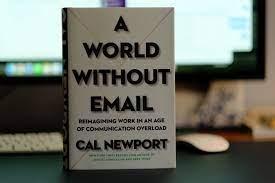A World Without Email Summary
Curated from: fourminutebooks.com
Ideas, facts & insights covering these topics:
13 ideas
·2.46K reads
18
Explore the World's Best Ideas
Join today and uncover 100+ curated journeys from 50+ topics. Unlock access to our mobile app with extensive features.
A World Without Email – Book Summary
A World Without Email presents a utopia where people engage in their usual professional activities without using emails as a means of communication, and explores a new way of working that doesn’t rely on instant messaging, which is known for decreasing productivity.
Your usual workday probably looks something like this: you get to work, check your emails for the first hour, and then you get to the practical side of things. You probably take a coffee break soon, check your emails again. The actual work done for the first half of the day doesn’t quite match the hours in the office.
32
440 reads
About the Book
Throughout the day, you check your inbox more than you actually work. But that’s alright, cause everyone else does the same. However, you then stress about the overload of work you have left. So you take it upon yourself to stay in overtime and finish up work. The solution might seem obvious – just turn off notifications.
However, practice shows us that it’s not so easy to do so. Instead, A World Without Email argues that we should get rid of the inbox overall and boost communication and productivity through other means.
32
273 reads
Here are three of the most useful lessons from the book:
- Emails kill productivity through the hyperactive hive mind workflow effect.
- Management execution apps are far more effective than emails in the long run.
- When you state your employee’s responsibilities in a clear manner, it’s more likely that they’ll get it done faster and better.
34
340 reads
Lesson 1: Instant messaging and emailing can decrease productivity drastically in the workplace.
Everyone uses emails at work – it’s just the way things are right now. Emails keep us connected and enhance collaboration within teams. Sounds good? That’s what the companies thought. However, it seems that communication through inboxes might do more harm than good.
On average, a worker checks their email every six minutes. One-third of our working day is spent navigating inboxes, and the average knowledge worker does an hour and 15 minutes of productive work a day, according to a study conducted by RescueTime.
32
216 reads
The main reason behind these demotivating numbers is that emails and notifications became like an addiction to us. And organizational cultures are pushing them to keep the collaborative flow going and increase responsiveness. The intention behind this concept is good, but in practice, it kills productivity.
That is because we are wired to only focus on one thing at a time. And keeping many tabs open and working with information in the back of our mind just doesn’t sit well with the prefrontal cortex. The result? Decreased attention, a lack of focus, and increased stress levels.
32
158 reads
Lesson 2: To improve productivity, we have to switch to project management execution apps instead of emails.
Emails are outdated project assignation tools, and for a reason. They decrease the attention span by keeping employees hooked to a constantly open tab. Not only that, but they also get messy and unstructured.
33
202 reads
Instead, business thinkers like Peter Drucker have better ideas when it comes to improving the workflow. Drucker acknowledged two types of work: the knowledge workers and the factory-type workers.
Factory-type workers are most efficient when they divide their work into smaller chunks and are responsible for their own small area of activity. With knowledge workers, things get a bit more complicated, because you can’t tell them how to be creative, but you can’t monitor them and inhibit their creative thinking.
32
141 reads
However, what you can do is interfere with the way they do things or their framework. Apps like Trello or Flow are specialized in assigning tasks and they limit the use of email to a great extent. This is great news because as we all know, emails do inhibit productivity.
Make sure to include employees in the workflow change and give them autonomy in their decisions. Always double-check with them to see if they like and agree with the changes and what tasks they’d like to receive.
32
121 reads
Lesson 3: People work best when they receive straightforward, coordinated tasks.
Emails are a great means of communication, but what happens when we don’t know what to communicate? Most of the time, they get in the way of productivity. The problem with emails is that people feel productive writing and reading them when they’re in fact not productive at all.
Many times over management agents noticed how people pass around tasks and explanations because no one really knows how to deal with them. Responsibilities are often misassigned, unaligned with deadlines or objectives, or ambiguous for the receiving end.
31
110 reads
For this reason, team members assign them between each other and spend precious working hours moving tasks around, without actually following up on them or getting things done. This phenomenon boils down to one solution: assigning employees straightforward, structured, organized tasks.
Every employee should receive work that is easy to understand, follow up on, and get done. A deadline is an effective way to set standards of operation, an “open door policy” is always a great idea to encourage communication. The best way to set these aspects in place is through management apps that deliver.
31
92 reads
A World Without Email – Book Review
A World Without Email is an informative piece of writing regarding the future of work without an inbox, instant messaging, and fast collaborative text apps.
The book presents an idea of the workplace where employees receive clearly-structured tasks and assigned responsibilities that they can fulfill without having to go back and forth about them on email apps.
Everything happens on management apps monitored by disseminators, and productivity spikes as an externality – doesn’t that sound great? It looks like we’ll have to try it out to see for ourselves.
32
94 reads
Who would I recommend the A World Without Email summary to?
The 30-year-old worker who wants to take a peek into the future of a knowledge worker’s day at work, the 49-year-old executive who wants to shape a more productive work environment, or the 37-year-old start-up founder who wants to gain a competitive hedge by establishing effective practices at their company from the early days.
32
111 reads
Author Quote
“Passion comes after you put in the hard work to become excellent at something valuable, not before. In other words, what you do for a living is much less important than how you do it.”
-Cal Newport
34
164 reads
IDEAS CURATED BY
CURATOR'S NOTE
A World Without Email - Book Review
“
Tom Joad's ideas are part of this journey:
Learn more about books with this collection
Leonardo da Vinci's creative process
How to approach problem-solving like da Vinci
The importance of curiosity and observation
Related collections
Similar ideas
5 ideas
7 ideas
7 Reasons why team communication is important for small businesses
getclariti.medium.com
9 ideas
9 Powerful Email Productivity Practices to Adopt Right Now
dansilvestre.com
Read & Learn
20x Faster
without
deepstash
with
deepstash
with
deepstash
Personalized microlearning
—
100+ Learning Journeys
—
Access to 200,000+ ideas
—
Access to the mobile app
—
Unlimited idea saving
—
—
Unlimited history
—
—
Unlimited listening to ideas
—
—
Downloading & offline access
—
—
Supercharge your mind with one idea per day
Enter your email and spend 1 minute every day to learn something new.
I agree to receive email updates


